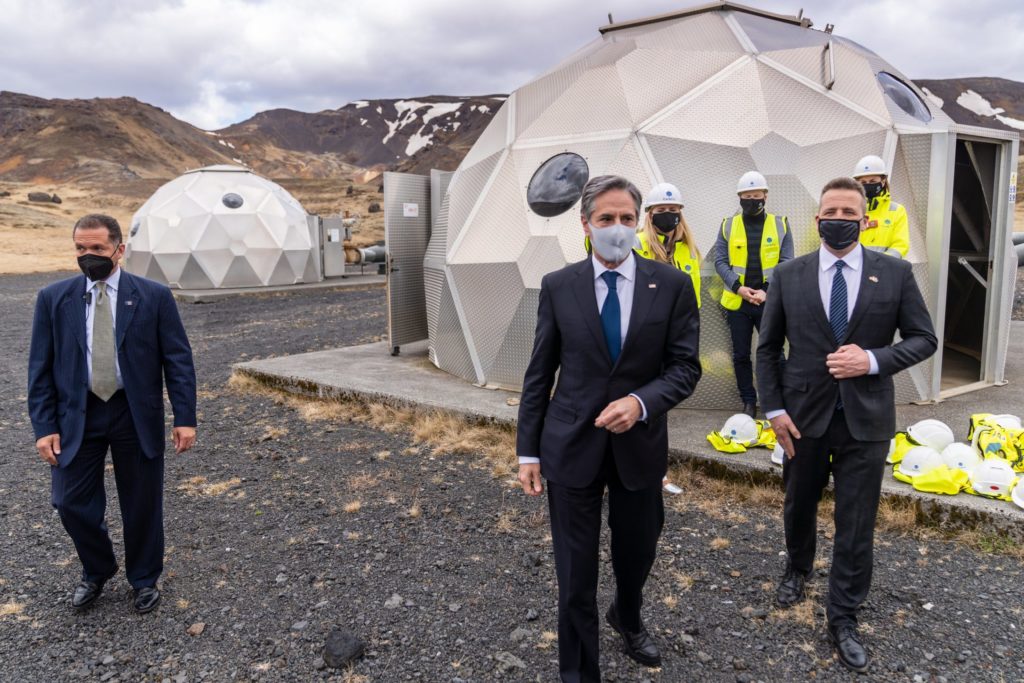Arctic Stewardship in Reaching Net Zero – Carbon Capture Solutions

The world has woken up. Woken up to the importance of reaching net zero by 2050 and building back better as we embark on a broad-based recovery following the COVID-19 pandemic. The road to net zero will require coordination, cooperation, bipartisanship and significant resource (re)allocation from every corner of the globe. We are all stakeholders in this.
The challenge is two-fold:
- Neutralise 51 billion tonnes of annual emissions of greenhouse gases by 2050 in order to limit prolonged damages to our planet
- Transform our energy systems and develop scalable carbon storage solutions
It is hard to understand the magnitude of this challenge. Where do we begin? On a very high level, the arithmetic of net zero emissions can be solved by reducing anthropogenic emissions and by applying sequestration solutions. The consensus seems to be that the emission reduction pathway is to be prioritised as the key lever of climate change mitigation but unfortunately the global energy industry is unaccustomed to rapid change. If we are to reach the goals set by the Paris Agreement to limit global warming to well below 2 degrees as a base case and preferably to 1.5 degree compared to pre-industrial levels, then Carbon Capture needs to be a big part of that equation.
The Arctic has a big role to play.
Reykjavik-based Carbfix has developed an economic and environmentally optimal solution, keyed CCM (Carbon Capture & Mineralisation). The project is located alongside the Hellisheidi Geothermal Power Plant, where it captures CO2 at the source and combines water to inject it into the basalt (ground). The carbonated water reacts with elements including calcium, magnesium and iron to fill empty spaces in the underground volcanic rock, and the solution transforms into stone within two years. This mechanism allows for permanent storage of the CO2. As of 5 March 2021, the company has converted 100,000 tonnes of CO2 (65%) and H2S (35%) into stone, a major milestone in underpinning its importance as a tool for climate mitigation. Carbfix aims to reach 1 metric gigatonne (a billion tonnes) of stored CO2 by 2030; and according to studies, the process could theoretically store 4 gigatonnes of CO2 in Europe and at least 7.5 gigatonnes in the US.
This solution is real and scalable; Carbfix has the ability to store carbon at a cost of USD25 a tonne versus the EU Emission Trading Scheme of EUR52 a tonne, the EU’s key policy tool in reducing emissions. The company is eyeing an increasingly meaningful project pipeline and is on the path to be a real climate change champion. More recently, Carbfix announced its plans for a new CO2 terminal that will receive CO2 transported by ship. The project, Coda Terminal, is expected to provide an annual storage of 3 million tonnes of CO2 once at full scale. Complementing the terminal, Carbfix has partnered with Dan Unity CO2 (originating from Danish shipowners Evergas and Ultragas) to supply the CO2 to Carbfix’s facilities. The project has received international attention, with US Secretary of State Anthony Blinken visiting the site and voicing his strong support for the technology and venture.
A second solution, Carbfix and Climeworks have teamed up for carbon removal, extracting CO2 directly from the atmosphere through Direct Air Capture (DAC). The project, Project Orca, captures 4,000 tonnes of CO2 per year, taking DAC and storage to new heights. Capture of CO2 from the atmosphere is far more challenging than source capture as atmospheric CO2 tends to be very diluted, at approximately 400 parts per million. Although with continued innovation and development, we will continue to push down the cost-curve and making scalability of such solutions a reality. (Currently, the cost of extraction is around USD1,200 per tonne). One of the main benefits of Direct Air Capture is to help offset unavoidable emission from industries like agriculture, which cannot be captured by using other methods.
Another project worth highlighting is the Northern Lights CCS Project off the coast of Norway. This full scale CCS projects is part of the Norwegian government’s ambition to develop a Carbon Capture & Storage value chain by 2024. The project includes the capture of CO2 from industrial sources in the Oslo region, from HeidelbergCement’s cement plant and Fortum Oslo Varme’s waste to energy plant. The liquefied and pressurised CO2 is shipped to Naturgassparken, an onshore terminal on the west coast, and it passes to intermediate storage tanks and is transported by pipeline to a North Sea subsea well for injection into a geological storage complex.
The project is led by a joint venture formed between Shell, Total and Equinor; and the project is to be developed in two phases. In phase 1, the concept capacity is to transport, inject and store 1.5 million tonnes of CO2 per annum; and thereafter, if the market demand supports further capacity, the JV partners will increase investment to deliver Phase 2. Phase 2 will have capacity to store an additional 3.5 million tonnes of CO2 per annum, bringing total capacity to 5 million tonnes per annum. Additionally, Northern Lights CCS has announced plans to assess direct air capture using Climework’s technology and further supply CO2 to the Northern Lights project, targeting the supply chain and other related emissions from the project process.
It is evident that carbon capture and storage is a key element in our toolkit in the fight against climate change. As we continue to transform our complex energy system, we need to develop in parallel the infrastructure for large scale carbon capture in order to reach the Paris Agreement goals. It is clear the Arctic has a strong role to play in this new and dynamic industry.